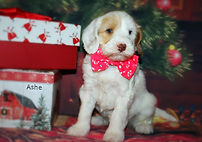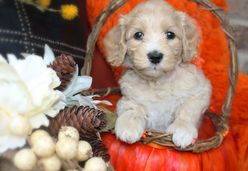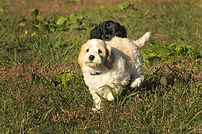



Bringing Home Puppy - What Do I Need?
You will need.....
1. A 30 inch or 36 inch crate for the puppy bedroom, based on size of pup.
2. Vitamins with pre and probiotics. We recommend NuVet (Important)
3. Dog Bed x 2 . You can find really nice ones at Homegoods, Marshall's , TJ Max and Ross.
4. Food and water bowl
5. Doggie name tag
6. Diaper wipes to clean hiney
7. Grooming supplies (pin brush, nail clippers, metal comb, et.)
8. Play pen area (for when he/she can't be watched -x-pens or baby playpens are very handy) with a linoleum remnant from Lowes or Home Depot to protect flooring
9. Chew toys (Lots)
10. Leash & collar (Lupine brand is guaranteed) and is also provided
11. Training treats
12. Crate pad (Serpa) with bumpers
13. Natures Miracle for cleaning accidents (No Clorox, vinegar, or multi cleaner. Must be specifically for dog enzymes and clean up
14. Bitter Apple for chewing
15. Puppy Tearless Shampoo for quick clean ups. (We use Burts Bees)
Bringing Home Puppy!!
-
Be consistent.
-
Love on your puppy.
-
Remember, puppies whole life is changing.
-
Use real marker words from the beginning; out, in, up, off, no, potty, poo, come, etc.
-
Take the time to make time for your puppy
-
Give the pup lots of love, toys, comfort, attention and a place for him/her to be alone if he wants it. Routine and security help them to settle in.
-
Puppy is only eight weeks old and teething, keep lots of chew toys.
-
Don’t hit puppy it destroys trust.
-
Don’t yell at puppy, it’s confusing and sounds like you are barking.
-
Remember, if you did not see it happen, just clean it up, puppy has moved on.
-
If you do see it happening, scoop up puppy and run to pee pad or out the door with a very firm admonishment for puppy.
-
Puppy will cry first few nights. If puppy sleeps and then wakens and start crying take him/her out to potty.
-
Be prepared to take puppy out in middle of night for a couple of weeks if you want him/her to potty train correctly.
-
Remember, crates are great for potty training, not for punishment
-
Expect to socialize your puppy if you want a well-balanced, unafraid, socially acceptable dog.
-
These puppies are people oriented dogs; integrate your puppy into your family life.
-
If you don’t have time for a puppy…..DON’T GET ONE!
-
Remember, train, train, train.
-
Be consistent (2xs)
-
Love your new best friend and family member by giving them reachable goals, providing them with the necessary resources to be successful (training) and consistently giving them rules, boundaries and limitation coupled with loving attention.
Spend puppies first year doing all of the above and you will have a phenomenal family member!!!!
240-522-1491




Australian Labradoodle Care & History






































The history of the Australian Labradoodle can be traced back to Australia when in the late 1980's Wally Conran, Breeding Manager for the Royal Guide Dog Association of Australia, was tasked with finding a dog that did not shed for a blind woman in need of a guide dog who was also allergy friendly. Wally thought it would be a piece of cake and came up with the idea of crossing a Labrador with a Poodle in an attempt to create allergy friendly dogs as guide dogs. Since that time Tegan Park Research Center and Rutland Manner Research Center took up the gauntlet to move forward with developing the breed we know today; the Australian Labradoodle. The infusion of the Irish Water Spaniel and the American and English Cocker Spaniel helped to stabilize the breed but Beverly's final infusion was the Soft Coated Wheaten Terrier. She thought this final infusion was spectacularly successful correcting some conformation concerns she had witnessed with previous breeding, along with the soft, suppleness of the fleece coat; hence, the robust, well balanced, offspring we know today and the fleece coat that we love.
-
Baby doodles are as cute and precocious as they come. Because of this, you must put aside your "Ohhh" factor and be somewhat firm right from the start; that is, if you want to save your shoes, socks, rubbery things, etc, as those little teeth are cutting through. Just a recommendation, but I would have plenty of cutting through toys around to exchange for the other "smell like my people, oh so much better" toy; just a suggestion.
-
First, decide if you are going to use potty pads or train straight to the outdoors. I recommend training straight to the outdoors. Locate an area that is both convenient for late night/early morning trips, typically close to a front or back door if you are going to train to the outdoors. If you have a covered patio or deck area, you may want to keep a potty box there for inclement weather days during initial training. If your puppy chooses a favorite spot and you don't already have a potty pad there, then move one there, if there are not necessary restrictions and remove the others. After you locate where you want puppy to potty, identify what word (s) you will use? Single words work well and then when you see your pup start to circle and/or squat say the word and give GREAT PRAISE when successful! Act a little foolish, they'll get it and want to please you more.
-
Crate training, while not required, is a significant tool in the potty training process. Your puppy does not have complete control of his/her natural callings. While they may seem really good, inevitably there will be an accident. Crate training allows you to be able to put puppy safely away when he/she can't be watched (continuously) and lets puppy know that there is a place just for him/her to relax and feel safe. He/she will protest initially, but within a few days, should adjust. Placing a couple of surprises, i.e., favorite/new chew toy and or small treat will certainly encourage comfort and acceptability; as puppy goes in and relaxes, then close the door. Our dogs are all crate trained but only sleep in their crates at night, for their afternoon nap or if I have to leave the house for a few hours. While their crates are available to them, they just like to follow us about the house during the day. And since we don't mind having several dogs traverse behind us, they get significant exercise as a bonus cause I'm moving from sun up to sun down' so when I say "Let's go crate" they are all grateful!
-
Feedings should occur at least three times a day for the first six months and then moved to a morning and early evening feeding if possible. A high quality kibble is a must for overall health and coat maintenance. I often infuse this with brown rice, veggies, eggs, and freeze dried meat. We don't use chicken as it tends to cause ear infections. I only give raw bones for chewing purposes but this is entirely a choice. A raw diet is also a choice for some. An early evening feeding gives your pup plenty of time to eliminate and to be very comfortable during the night.
-
A daily brush comb through makes the coat manageable. Especially with puppies, I do a comb through right before bedtime as it is both calming and socializes your puppy to the grooming process. Play with his/her paw pads, ears, eyes, and underbelly; wipe the rear end and toileting parts clean. Between the ages of six and 14 months, your doodles adult coat will come in. During this time it is essential that you increase combing, not brushing, as this helps to stip out the puppy coat and prevents the inevitable matting that will occur without careful combing during this time period. After this time, you may resumen combing a couple times a week sufficiently.
-
Your doodle should be bathed at least every five to six weeks. In between bathing you can administer "hygiene" baths. A hygiene bath is simply taking care of the important areas until you can do a full bath. Thorough brushing and combing with an actual wide tooth comb works wonders. Baby wipes are ideal for cleaning the private parts and small flea combs for the eye boogies; don't forget to keep the ears free of debris and hair. Excessive hair can cause ear infections.
-
Clipping toes...even as a puppy you will need to keep the hair from between the toe pads and the nails clipped. Don't forget the dew claws as it can grow into the skin and cause injury if not attended to. Also, the dew claws can be painful if you hit it during grooming time so be gentle around that area.
-
Monitor when your puppy eats and drinks and how long it is before puppy is ready to eliminate; this may take several tries but usually within ten to fifteen minutes of eating for some, and up to 30 minutes for others.
-
Puppies most often have to go to the potty under the following conditions:
-
Just after awakening go! Right away! Don't brush your teeth or meander around, get pup out to potty, their little bladders can't hold that long.
-
After grooming and or bath, they will potty,
-
After rough housing or play, indoors or out,
-
After eating and or drinking,
-
Roughly, about every hour and a half when pup first comes home take him/her to potty, and then extend it each month by an hour. So if pup is three months old, if crated, he can hold for up to four hours, if not crated, take pup out every three hours or after the aforementioned times.
-
Don't forget to teach pup to alert you to his/her need to go potty. Bells work really well. They will signal your, just watch.
-
If you smell a doggie type odor, check the ears for the smell. From time to time a doodle may contact and ear infection. Rather than bathe, because they do not typically have those types of odors, take to vet for ear exam. Pups ears should be cleaned regularly, we use an ear wash recommended by our vet, and excessive hair in the ear canal can be a cause for yeast or bacterial build up.
-
One book I would HIGHLY recommend is "Love That Dog, Training Program" by Dawn Sylvia-Stasiewicz". One of the best books on the market for both new pet owners and old timers as well. It has a well thought out schedule (for those who ask about schedules), pictures and step by step instructions, troubleshooting guides and just plain old good common sense. This is especially helpful for first time puppy owners as her methods are tried and true.
CARING FOR YOUR DOODLE





